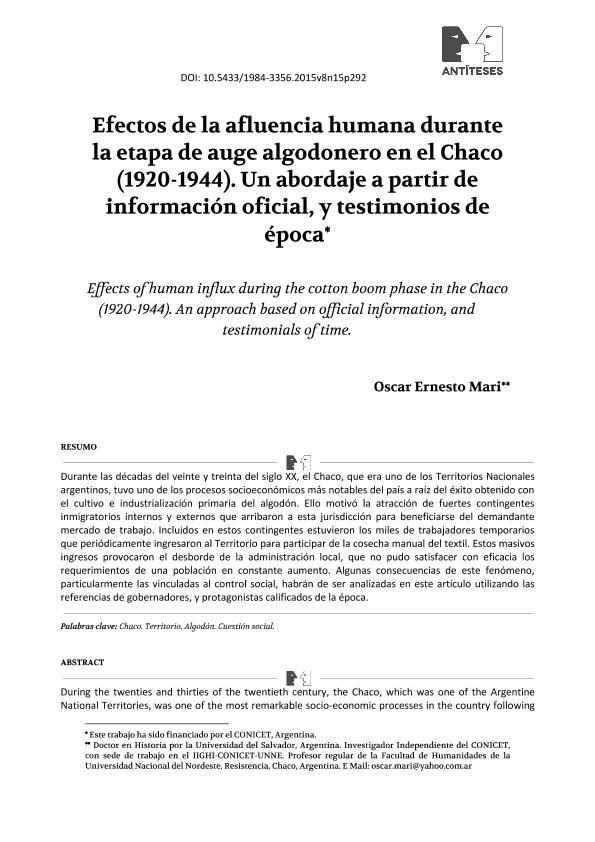Mostrar el registro sencillo del ítem
dc.contributor.author
Mari, Oscar Ernesto

dc.date.available
2016-12-16T17:14:41Z
dc.date.issued
2015-06
dc.identifier.citation
Mari, Oscar Ernesto; Efectos de la afluencia humana durante la etapa de auge algodonero en el Chaco (1920-1944). Un abordaje a partir de información oficial, y testimonios de época; Universidade Estadual de Londrina; Antíteses; 8; 15; 6-2015; 292-312
dc.identifier.issn
1984-3356
dc.identifier.uri
http://hdl.handle.net/11336/9577
dc.description.abstract
ResumenDurante las décadas del veinte y treinta del siglo XX, el Chaco, que era uno de los Territorios Nacionales argentinos, tuvo uno de los procesos socioeconómicos más notables del país a raíz del éxito obtenido con el cultivo e industrialización primaria del algodón.Ello motivó la atracción de fuertes contingentes inmigratorios internos y externos que arribaron a esta jurisdicción para beneficiarse del demandante mercado de trabajo. Incluidos en estos contingentes estuvieron los miles de trabajadores temporarios que periódicamente ingresaron al Territorio para participar de la cosecha manual del textil.Estos masivos ingresos provocaron el desborde de la administración local, que no pudo satisfacer con eficacia los requerimientos de una población en constante aumento.Algunas consecuencias de este fenómeno, particularmente las vinculadas al control social, habrán de ser analizadas en este artículo utilizando las referencias de gobernadores, y protagonistas calificados de la época.
dc.description.abstract
During the twenties and thirties of the twentieth century, the Chaco, which was one of the Argentine National Territories, was one of the most remarkable socio-economic processes in the country following the success of the primary culture and industrialization of cotton. This motivated the attraction of strong internal and external immigration quotas that arrived in this jurisdiction for plaintiff's benefit labor market. Included in these quotas were the thousands of temporary workers who regularly entered the Territory to participate in manual harvesting textiles. These massive revenues caused the overflow of local government, which could not effectively meet the needs of a growing population. Some consequences of this phenomenon, particularly those related to social control, must be analyzed in this article using the references of the governors, and skilled players of the era.
dc.format
application/pdf
dc.language.iso
spa
dc.publisher
Universidade Estadual de Londrina

dc.rights
info:eu-repo/semantics/openAccess
dc.rights.uri
https://creativecommons.org/licenses/by-nc-sa/2.5/ar/
dc.subject
Chaco
dc.subject
Territorio
dc.subject
Algodón
dc.subject
Cuestión Social
dc.subject.classification
Otras Historia y Arqueología

dc.subject.classification
Historia y Arqueología

dc.subject.classification
HUMANIDADES

dc.title
Efectos de la afluencia humana durante la etapa de auge algodonero en el Chaco (1920-1944). Un abordaje a partir de información oficial, y testimonios de época
dc.title
Effects of human influx during the cotton boom phase in the Chaco (1920-1944). An approach based on official information, and testimonials of time
dc.type
info:eu-repo/semantics/article
dc.type
info:ar-repo/semantics/artículo
dc.type
info:eu-repo/semantics/publishedVersion
dc.date.updated
2016-11-23T18:18:34Z
dc.journal.volume
8
dc.journal.number
15
dc.journal.pagination
292-312
dc.journal.pais
Brasil

dc.journal.ciudad
Londrina
dc.description.fil
Fil: Mari, Oscar Ernesto. Consejo Nacional de Investigaciones Científicas y Técnicas. Centro Científico Tecnológico Nordeste. Instituto de Investigaciones Geohistóricas (i); Argentina
dc.journal.title
Antíteses
dc.relation.alternativeid
info:eu-repo/semantics/altIdentifier/doi/http://dx.doi.org/10.5433/1984-3356.2015v8n15p292
dc.relation.alternativeid
info:eu-repo/semantics/altIdentifier/url/http://www.uel.br/revistas/uel/index.php/antiteses/article/view/14157
Archivos asociados
